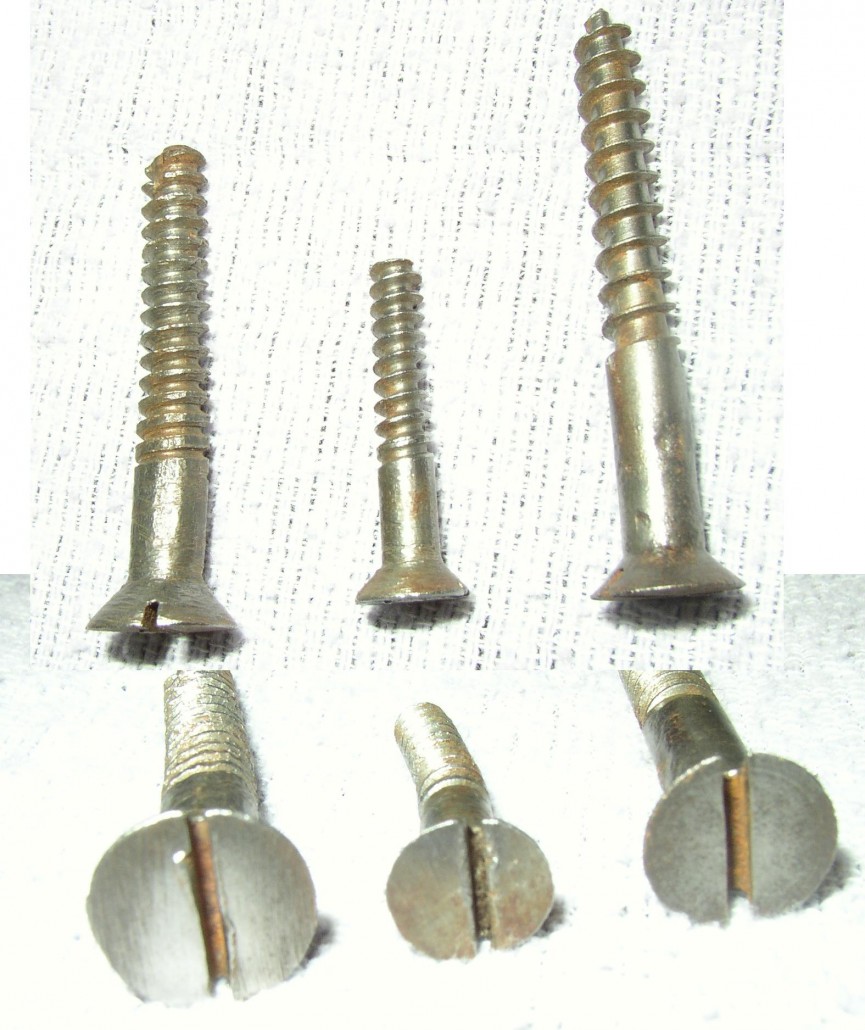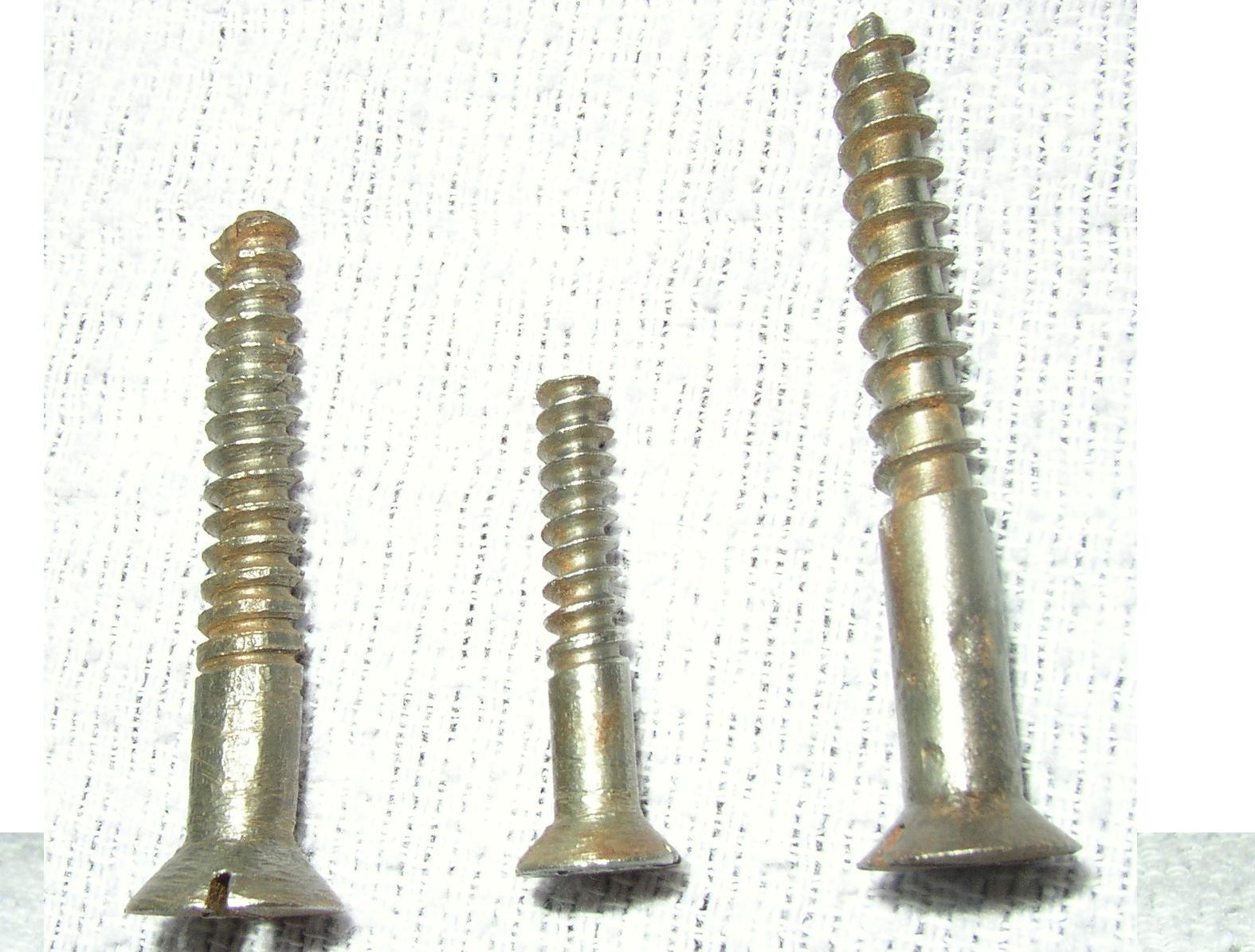
CRYSTAL RIVER, Fla. – Like old nails, old screws often have an important tale to tell in determining the date of an older or antique piece of furniture. Since technology often leaves clues to its development, knowing the history of the manufacturing process of screws can help interpret the clues.
The idea of a screw has been around for many centuries. The ancient Greek inventor Archimedes used a screw to elevate water in a column. Leonardo da Vinci used the concept of a helix in his design of the first helicopter – which is logical since a helix is simply a circular ramp. And a ramp is one of the basic tools of physics that allows us to increase the force we can apply to a given object. (Other basic tools include the lever and the pulley.)
The screw, as it turns out, is simply a ramp wrapped around a column for convenience. This arrangement allows the fastening of two flat surfaces together without penetrating the opposite side of the second surface as would be required by clinching nails. The force that can be applied with a screw is constant and continuous and can be altered simply by turning the screw.
The values of these properties are immediately obvious when applied to cabinet and furniture making. A screw allows a tabletop to be fastened to a base without marring the top and it allows hinges to be mounted on a door or drop leaf without breaking the finished surface.
The idea of the screw and its usefulness is clear, but the practical implementation of the idea turned out to be a bit more difficult, and these early efforts at making a screw from metal are what provide clues.
In the 17th, 18th and early 19th centuries, screws were produced one at a time, often by the same mechanic who made nails – the blacksmith or the “nailer.” The screwmaker started with the same square iron stock from which nails were forged, but this time the stock was heated and then pounded into a more or less cylindrical configuration as befits the body of a screw. The stock was then cut to the desired length and slipped into a form called a swage block on the anvil where a circular head was pounded out. The slot was cut with a hacksaw or chisel. Then came the hard part – the threads. Usually lacking a cold steel die with which to cut the threads, the artisan had to file the threads by hand and eye to produce a useful fastener.
All these handwork steps inevitably left marks and a handmade screw will usually exhibit one or more of the common identifiers of handwork. These include flat spots on the unthreaded portion of the shaft where the square nail stock was not rounded out completely, a slot off center to the head, a less than perfectly circular head that is often off center of the shaft, uneven threads with varying pitch and depth, tool marks on the throat below the head where the soon-to-be-screw was held by tongs during the heating process and a blunt tip which often shows the cut marks where the cylinder was cut to size. The final distinguishing characteristic of a handmade screw is the body of the screw itself. It is almost always perfectly cylindrical with no taper from top to bottom. But be careful because, while nearly all handmade screws are cylindrical, not all cylindrical screws are handmade since that is a trait also shared with the early versions of machine- made screws, which appeared in the second quarter of the 19th century.
Since all screws were handmade in the 18th century, each one was a creation unto itself and no two were identical, and thus not precisely interchangeable. This creates an obligation on the part of any collector or restorer who removes handmade screws from furniture to individually identify each screw and return it to its original position.
While nail-making machinery and technology advanced rapidly in the late 18th and early 19th centuries, screw-making moved forward at a slower pace. The first screw-making machinery appeared around 1812, but its importance was overshadowed by another major historical event, the War of 1812, which engulfed the major manufacturing centers of the East Coast.
It was not until the early 1830s that automated screw-making really took hold. And when it did, it really took off. Suddenly it seemed, screws were readily available to any cabinetmaker just for the asking and the price was right. The screws were of high quality and more importantly each screw in each batch was virtually identical to the one before and after it. This meant that screws were now interchangeable and reliably a given length. The cabinetmaker could depend on them.
While the new machinery turned out lots of essentially identical screws, its main forte was in cutting perfect threads on uniformly round bodies. The early machinery did not address the subject of head and slot making. These two vital operations were still performed by hand and thus were imperfect. Heads were still found slightly off center to the shaft and slots were often off center to the heads. And the new screws shared the original cylindrical shape of their ancestor with no taper and a blunt tip.
Finally, in the late 1840s, the idea of a pointed, tapered shaft dawned and a patent was issued in 1848 for the “gimlet” screw – the precursor of all modern screws. This innovation meant that the cabinetmaker and factory worker no longer had to drill a perfect pilot hole for each screw – just get it started and it would power its way into the material.
Later changes in screw technology primarily involved the composition of the metal of the screw and the configuration of the head. The machinery of the mid-19th century finally learned how to make perfect heads so innovation focused on variations of the slot, mainly to allow installation of the screw by machine power. During the 20th century slot variations have included the Phillips head, the Reed and Prince, the clutch, the torx and the square recess, all requiring design specific drivers to install.
But even with these variations of slot and composition the main technology of the screw as a ramp wrapped around a tapered, pointed column has remained unchanged for more than 150 years.
_____
By FRED TAYLOR
Send comments, questions and pictures to Fred Taylor at P.O. Box 215, Crystal River, FL 34423 or email them to him at info@furnituredetective.com. Visit Fred’s newly redesigned website at www.furnituredetective.com and check out the new downloadable “Common Sense Antiques” columns in .pdf format.
His book How To Be a Furniture Detective is available for $18.95 plus $3 shipping. Send check or money order for $21.95 to Fred Taylor, P.O. Box 215, Crystal River, FL, 34423.
Fred and Gail Taylor’s DVD, Identification of Older & Antique Furniture ($17 + $3 S&H) is also available at the same address. For more information call 800-387-6377 (9 a.m.-4 p.m. Eastern, M-F only), fax 352-563-2916, or info@furnituredetective.com. All items are also available directly from his website.



